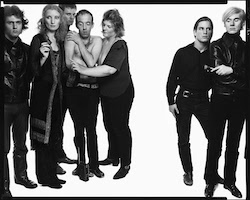
NEW YORK – To celebrate the centennial of Richard Avedon’s birth in 1923, the Metropolitan Museum of Art will present a selection of the photographer’s most innovative group portraits in the exhibition Richard Avedon: MURALS, opening Thursday, January 19 and continuing through October 1. Although Avedon first earned his reputation as a fashion photographer in the late 1940s, his greatest achievement was his stunning reinvention of the photographic portrait. Focused on the short period between 1969 and 1971, this exhibition will explore a critical juncture in the artist’s career, when, after a hiatus from portraiture, he began working with a new camera and a new sense of scale. The exhibition will be organized around three monumental photomurals in the Met collection (the largest measures nearly 10 by 35ft) that depict the era’s preeminent artists, activists, and politicians. Uniting the murals with session outtakes and contemporaneous projects, the exhibition will track Avedon’s evolving approach to group portraiture, through which he transformed the conventions of the genre.
The exhibition is made possible by Joyce Frank Menschel.
For Avedon, the oversized mural format expanded the artistic possibilities of photography, radically reorienting viewers and subjects in a subsuming, larger-than-life view. In the murals, he assembled giants of the late 20th century — members of Andy Warhol’s Factory, architects of the Vietnam War, and demonstrators against that war — who together shaped an unprecedented era of American life. The formal innovations of Avedon’s high style — of starkly lit bodies in an unsparing white surround — are most fully realized in these enormous group pictures, in which subjects jostle and crowd the frame, and bright voids between them crackle with tension. Presented in one gallery, the murals will stage an unlikely conversation among historically opposed groups, as well as contemporary viewers.
The show will also feature loans from the Avedon Foundation, including a selection of outtakes that will bring viewers behind the scenes, illuminating the artist’s creative process. Avedon arranged sittings at Warhol’s Factory during a period of months, but had only a matter of minutes to photograph the American military leadership in Saigon. Working prints from the various mural sessions will illustrate Avedon’s graphic and narrative aims for the project, as well as his masterful manipulation of figures in space. Alongside this rare material, related photographs — of activists in New York, and other groups in Vietnam — will reveal the dynamism and breadth of Avedon’s portraiture.
Nearly 20 years after his death in 2004, Richard Avedon: MURALS will mark the artist’s extraordinary legacy as well as his special relationship with the Met. The murals are gifts from the artist himself, donated on the occasion of his 2002 retrospective at the museum. Reunited for his centennial, these works render in spectacular detail the intimacies and interpersonal dynamics that preoccupied Avedon throughout his life.
Visit the website of the Metropolitan Museum of Art and see its dedicated page for Richard Avedon: MURALS.


